Ijraset Journal For Research in Applied Science and Engineering Technology
- Home / Ijraset
- On This Page
- Abstract
- Introduction
- Conclusion
- References
- Copyright
Formulation of Hand Made Soap by using Goat Milk
Authors: Uma Ganesh There, Swanand Kalambe, Vikas Choudhary
DOI Link: https://doi.org/10.22214/ijraset.2022.40427
Certificate: View Certificate
Abstract
Hand Made Soap is a mingle of both science and art by combining scientific knowledge and artistic creature. Cost-effective, skin and eco-friendly handmade soap has been developed by a cold process of saponification by using food-grade, natural ingredients with vegetable oils such as coconut oil, palm oil with active ingredients such as goat milk, and essential oil. The addition of fresh goat milk is the main challenge due to heat generation by caustic lye during the saponification process. The caustic soda in soap formula is caramelize the sugar in the milk, turning soap a bright brown color or curdles the milk. Hence, the study has been initiated and developed a standardized formula with desired qualities, color, and texture. The experiment studied physio-chemical parameters and dermatological tests of five different formulations of goat milk soap.
Introduction
I. INTRODUCTION
Skin is the most revealed part of the body which is prone to various foreign particles which may lead to various skin-related disorders. Therefore, to prevent the skin from various disorders there is a need for proper cleanliness as well hygiene for the most exposed part of the body and prevent it from micro-organism spread in the environment thus, preventing various disorders of the skin [1]. The better and more efficacious way to remove all the foreign particles is the use of simply formulated soap with no extreme chemicals. Goat milk is preferred in formulating the soap as the active ingredient due to its wonderful properties for sensitive and dry skin [4].
II. BENEFITS OF GOAT MILK SOAP
Goat milk and its products have played an important role in the economic viability in many parts of the world, especially in developing countries. Goat milk has many benefits that can help make the skin look younger. It also has soothing elements that make rough and damaged skin soft and healthy. Sometimes it is noticed that skin turns dry and irritated after a shower. This may be due to using synthetic soap. According to the Food and Drug Administration (FDA), there are very few real soap products on the shelves of stores.
III. METHODOLOGY
Cold process is the highly preferable process for making Handmade soaps. The process involves combining oil such as Coconut oil and palm oil with an alkali such as caustic lye (Sodium hydroxide). This results in a chemical reaction that binds the two ingredients together and this is called saponification. This leads to the formulation of soap, glycerin, and water. The natural occurrence of glycerin in the process of making handmade soap is one reason why handmade soaps are widely preferred over commercial soaps.
An experiment of this study is followed the three main steps as follows.
- Selection and validation of raw materials for making handmade soap.
- Optimization of composition/formulation of soap.
- Evaluation of Physiochemical parameters as per Indian Standards and microbiological efficacy study.
A. Collection of Materials / Ingredients
Coconut oil, Palm oil, stearic acid, caustic soda, and essential oils were obtained from Maharashtra Scientific Emporium, Wardha, Maharashtra, India. Goat milk is procured from Vidarbha Pasu Unnati Sansadhan Kendra, Wardha, Maharashtra, India. one of the most common base oils used in soap making is unrefined coconut oil and there is a purposeful reason for its excellent cleaning and foaming properties because of its higher fraction of lauric acid 44-52%. Palm oil is very high in palmitic acid which makes the soap hard and long-lasting. the best part is that goat milk can penetrate the surface layer of the skin fast and break down the bonds between the dead cells and keep the skin healthy and nourished.
B. Formulation Of Handmade Soap
Hand Made Soap is made by cold process method by combining oils and caustic lye solution at 40-45 o C. Mixing these two components together will create both soap and glycerin and the glycerin left acts as a moisturizing agent. Before saponification, the temperature is usually raised to a point sufficient to ensure the complete melting of the fat being used. The five different composition of soaps contains essentially coconut oil, palm oil, stearic acid and is formulated with natural ingredients like goat milk, essential oils..
Sodium hydroxide or Caustic soda flakes are calculated by using the Saponification value of the selected oils. Caustic soda lye solution comprised one part of the caustic soda flakes dissolves in three parts of the distilled water.
The method of making handmade soap comprises of following steps
- Preparation of caustic Lye solution: Caustic soda (Sodium Hydroxide) lye solution has been prepared by dissolving in three parts of dissolution liquid. The three portions of the dissolution liquid are divided into five different concentrations with goat milk and distilled water for comparative study.
- Saponification: The Mixture of oils and fatty acids are simply melted (at 50-70oC) in a vessel equipped with a mechanical stirrer and the calculated amount of caustic soda solution along with goat milk is added with vigorous stirring at 40-45 o C. The fats and oils are mixed for a short time, usually from about ten minutes to one hour, or before the soap becomes too viscous to pour, and finally, the other additive such as essential oil and fragrance are added with gentle mixing. At this time the saponification is about 90% complete.
- Moulding: Hand-made soap is a viscous liquid when first made, and is then poured into molds to harden and kept for air dry for approximately four to six weeks at room temperature. This is known as the curing time and it will allow for any excess water to evaporate out of the soap and to complete 100 % of the saponification process. It's best for the soap to be in a cool, dry location, not touching anything else, while it is drying.
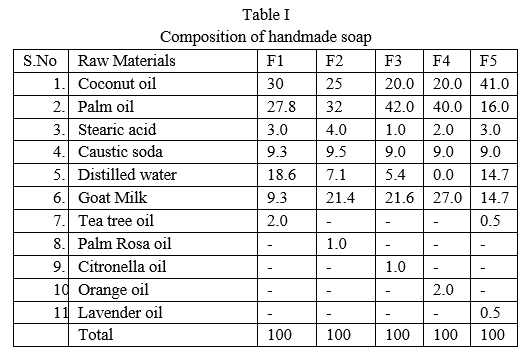
???????C. Evaluation Of Physiochemical Parameters
The quality of the soap is depending on various factors such as the type of oils used such as coconut oil, palm oil, olive oil, etc [2] and type of alkali used, its hardness, TFM, Foam Height, Solubility, etc. The parameters mentioned in Table II, are tested as per the Indian standards Requirements.
- Moisture content: Moisture content has been determined by oven method: 5 g of the soap in a Petri dish was dried to constant mass in an air oven at a temperature of 105oC. Cooled in a desiccator and weighed.
Moisture Content, percent by mass = 100 m/M
m = loss in mass in g of the material after drying and
M = mass in g of the material taken for the test.
2. Total Fatty Matter: 5 g of the soap was dissolved in 100 ml of distilled water in 250 ml conical flask. When dissolution is completed, diluted Sulphuric acid (1:1)was added and heated the flask until the fatty acids separate as a clear layer. 50 ml of sodium chloride solution was added and cooled. Transferred quantitatively to a separating funnel, drawn off the aqueous acid layer. Shacked well with three-50 ml portion of ethyl ether and distilled water. Evaporated the ether layer on a boiling water bath. Dried the fatty matters to constant mass in an air oven 105oC and weighed.
Total Fatty Matter, percent by mass = 100M1/M2
M1 = mass in g of the fatty matter, and
M2 = mass in g of the material taken for the test.
3. Free Caustic Alkali: 10 g of the sample digested in 100 ml of ethyl alcohol into a 250-ml flask, heated in reflux condenser and immersed into a boiling water-bath, until the soap is dissolved. 5 ml of barium chloride solution added into the solution to eliminate traces of carbonates which are usually present. Add a few drops of phenolphthalein indicator and titrated with standard sulphuric acid or hydrochloric acid.
Free caustic alkali (as NaOH), percent by mass = 4VN/M
V = volume in ml of standard sulphuric acid or hydrochloric acid used,
N = normality of standard sulphuric acid or hydrochloric acid, and
M = mass in g of the material taken for the test.
4. Foam Height: For the determination of the soap for its ability to form foam about 1.0 gm of soap was taken and dissolved in distilled water (about 50ml) in a 100 ml graduated measuring cylinder. The measuring cylinder was then shaken for about 2-3 minutes and it was allowed to stand for about 10 min. Foam height was measured after 10 minutes. Recorded the observation for three consecutive experiment and the mean was taken.
5. Mush Value: The Mush Value was determined by Tablet-Immersion Method. 80 g of the soap bar was cut down to a rectangular block and 50 mm from the bottom of the soap bar was immersed in demineralized water at room temperature for exactly 2h. Removed the soap bar and left for about 1 min to drain off the excess water. Carefully scraped off all the mush. Repeated the above steps again
Loss in mass due to mush, M = M1 – M2
Mush = M x 50/A
A = surface area in cm2 calculated taking into consideration five faces of the tablet immersed.
6. Freedom from Grittiness: Kept the bathing bar under running water at a temperature of 30°C and rubbed gently the two sides of the bar on the palm for 3 min. No gritty or rough feel is perceived while rubbing the bar surface.
7. Freedom from Cracking: Minimum of 10 samples was taken for testing purpose. Rubbed each tablet in a pool of distilled water maintained at 27 ± 2 °C in a bucket by rotating the tablet 50 times between the palms and then allowed the tablets to dry in a humidity chamber at 38 °C and 70 percent relative humidity for 24 h. No cracking was observed.
8. Cleaning Efficiency: A fixed volume of oil was applied on the inner palms of at least 10 panelists and recorded their observations on the presence/ absence of oily feel at the end of a prescribed washing procedure. If 70 percent of the panelists record an absence of oily feel, the tablet is considered to have passed the cleaning test.
9. Skin Irritation Test: The purpose of this test was to evaluate the irritative potential of the product when applied to the skin. The most effective method for determining the incidence of irritative contact dermatitis due to the use of topical drugs or cosmetics is the patch testing Method. The products must remain in contact with the skin for a certain period of time if their irritative potential is to be evaluated. [3]. Irritation skin test, conducted through occlusive patch-test methods, is helpful to point out moderate or strong irritants. The study was conducted on 40 healthy volunteers, male and female, between the ages of 18 and 65. The skin is cleaned with a 70% solution of alcohol and the samples are applied on the skin and covered with adhesive strips. [3]. Skin reactions are observed 15 min and 24 hr after the strips have been removed.
???????D. Scoring the Result
At each reading (15 min, 24 hr) each application site is scored according to the above scale for erythema and for edema, and the sum of the two scores (erythema and edema) is calculated. The average of the final scores for all subjects was calculated for each product. The Final Results Table contains the average group scores at each reading for each product tested.
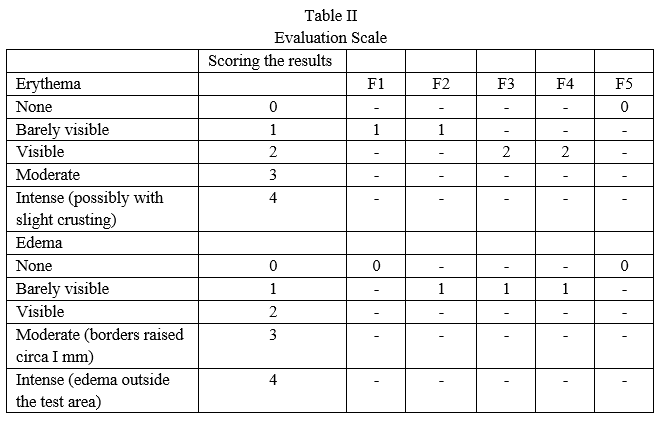
???????E. Classification of the Product
Each product was classified as a non-irritant, a mild irritant, a moderate irritant, or a strong irritant according to a modification of the scale. This modified scale, which considers as non-irritants only those products with scores of less than 0.5, allows distinguishing more easily between mild, non-specific reactions and those that are due to the test substance itself [3]. The result demonstrated that the formulas F1-F4 are showing mild and moderate irritants on the volunteer’s skin. The formula F5 is showing the score ? 0.5 and it can be classified as a Non-irritant to the human skin.
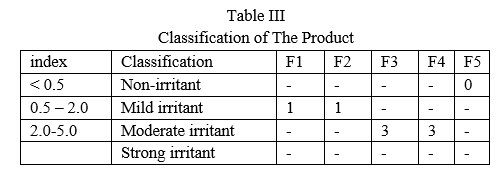
F. ??????????????Zone of Inhibition Test
The soap solutions of various concentrations were tested for their antimicrobial properties by disc diffusion method against Staphylococcus aureus. In this method, the soap solution of Sample F1-F5 was prepared by dissolving 1 g of soap in distilled water. The antibiotic used in control is ciprofloxacin- 5 μg. Inoculated a loopful of staphylococcus aureus in 5 ml of tryptone soya broth and incubate at 37oC for about 18 hours. Towards the end of this period, a count of about 2.8 x 108 is obtained. 0.5 ml of the 18 hours culture of staphylococcus aureus mixed thoroughly in 20 ml of sterilized tryptone soya agar and poured into sterilized Petri plates. Pipetted out 10 microliters of samples F1-F5 dilutions into sterline filter paper discs, dried in air for mins, and placed into the seeded plates. Incubated the plates at 37oC for 24 – 36 hours. Observed the zone of inhibition around the disc.
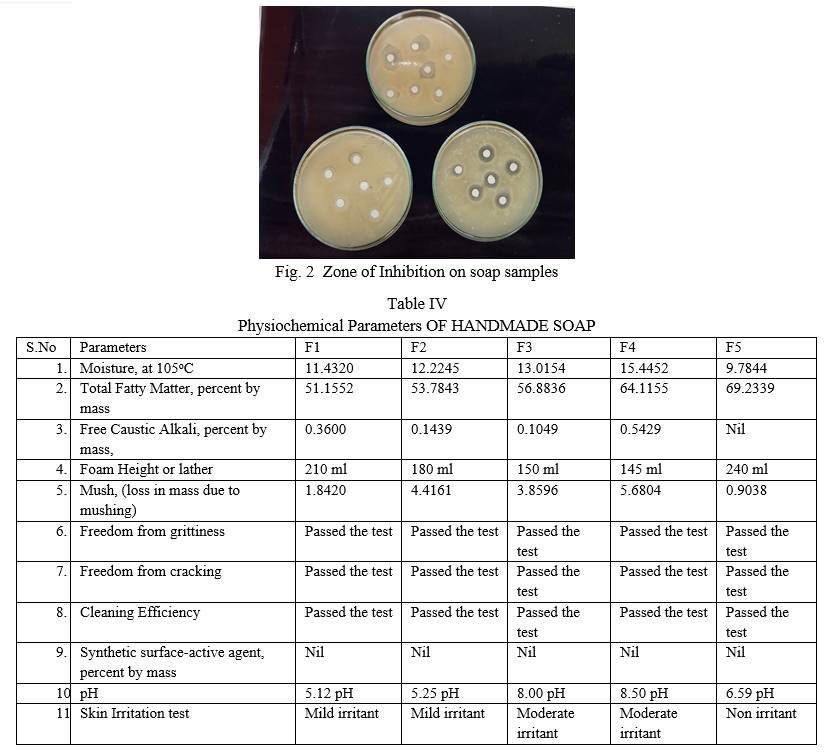
???????G. Skin Brightening And Skin Moisturizing Result
The Significant use of the soaps during the one-week period and the users reported that excellent moisturizing properties were found and reduced the roughness of the skin. Likewise, the research also conducted the skin brightening level on the skin. The study indicated that the skin on the users who used the soap brightened during a one-week period.
???????H. Result And Discussion
The goat milk-based hand-made soap results of various evaluation parameters of the five concentrations are shown in Table IV. The table depicts the comparative study of the five formulated samples (F1, F2, F3, F4, F5) as per the Indian Standards of the bathing bar and Toilet Soap. pH and free caustic alkali of the F5 Sample were optimum for its utilization on the skin. Higher, as well as lower pH, refers to the not suitable for the skin. The foaming ability of the all formulation F1-F5 was found in the range of 150-240 ml while the foam retention time was found to be 10 minutes. This means lather producing ability of the oil combination of this formulation was satisfactory. The quality of soap is represented by the total fatty matter. If the total fatty matter is lower, then it is not optimum for dry skin. The greater fatty matter is best for a deep-cleansing property on the skin. Hence, the total fatty matter of the F5 sample is higher than other samples. The moisture content of Formula F5 is shown at 9.7844% which is suitable for all climatic conditions. The storage stability also will be increased for F5. In addition, antibacterial testing was successfully performed.
The evaluation test showed that the goat milk and essential oil in all formulations F1-F5 have satisfactory antibacterial results with successful inhibitions of the micro-organism S.aureus as compared to standard antibiotics. Moreover, essential oils are added to treat various skin infections and for aroma effects. In addition, the fragrance of the soap, moistening ability, compatibility of the skin was also performed by applying on the skin.
Based on the results, it was realized that among the five formulations F1- F5, F5 is contained higher TFM, and foam values, less mush value due to an equal proportion of goat milk and distilled water in the formulation. The pH of F5 Sample was optimum for its utilization on the skin. The analysis report led to an outcome of the formulation F1 is stable goat milk soap possessing potent antimicrobial activity against various micro-organisms such as E-Coli and S.aureus and can therefore be classified as good quality and also found to be used for daily use and did not cause any skin irritation. Therefore, these are the small initiatives, for environment/health sustainability to contribute to the enhancement of human health and quality of life by adopting responsible formulations of environment-friendly soap products & ingredients.
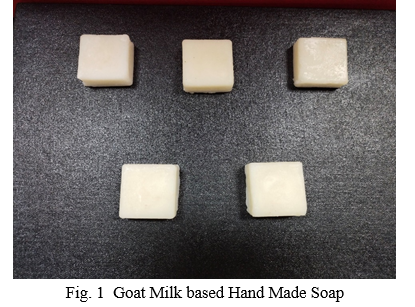
IV. ACKNOWLEDGMENT
The authors express their gratitude to the team of Maharashtra State Rural Livelihood Mission, Babhulgaon and members of Vidarbha Pasu Unnati Sansadhan Kendra, Wardha, Maharastra, India for adopting this technology and for financial support for this work.
Conclusion
Based on the results, it was realized that among the five formulations F1- F5, F5 is contained higher TFM, and foam values, less mush value due to an equal proportion of goat milk and distilled water in the formulation. The pH of F5 Sample was optimum for its utilization on the skin. The analysis report led to an outcome of the formulation F1 is stable goat milk soap possessing potent antimicrobial activity against various micro-organisms such as E-Coli and S.aureus and can therefore be classified as good quality and also found to be used for daily use and did not cause any skin irritation. Therefore, these are the small initiatives, for environment/health sustainability to contribute to the enhancement of human health and quality of life by adopting responsible formulations of environment-friendly soap products & ingredients.
References
[1] Shah, M.A. Satheesh Babu Natarajan, M. Gousuddin, Formulation, Evaluation and Antibacterial Efficiency of Herbal Hand Wash Gel Int. J. Pharm. Sci. Rev. Res, 2014, 25(2): 1202014). -124. [2] J. Arasaretnam S and Venujah K, Preparation of Soaps by Using Different Oil and Analyze their Properties, Department of Chemistry, Eastern University, Chenkalady, Sri Lanka, 2019, 7:1, Volume 7 • Issue 1 • 1000357 [3] L.Celleno, A Mastroianni, AVasselli, M.V. Tolaini, F. Macchia. Department of Dermatology. Dermatological evaluation of cosmetic products for skin detergency, J Appl Cosmetol 11. 1-22, 1993. [4] Rakesh K. Sindhu*1 , Mansi Chitkara2 , Gagandeep Kaur1 , Arashmeet Kaur1 , Sandeep Arora1 and I.S. Sandhu2, , FORMULATION development and antimicrobial evaluation of polyherbal soap, Chitkara College of Pharmacy, Chitkara University , 2019.
Copyright
Copyright © 2022 Uma Ganesh There, Swanand Kalambe, Vikas Choudhary. This is an open access article distributed under the Creative Commons Attribution License, which permits unrestricted use, distribution, and reproduction in any medium, provided the original work is properly cited.

Download Paper
Paper Id : IJRASET40427
Publish Date : 2022-02-20
ISSN : 2321-9653
Publisher Name : IJRASET
DOI Link : Click Here
 Submit Paper Online
Submit Paper Online

